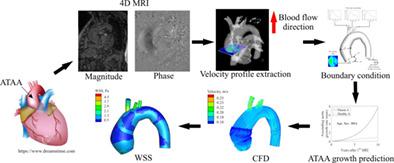当前位置:
X-MOL 学术
›
Int. J. Numer. Method. Biomed. Eng.
›
论文详情
Our official English website, www.x-mol.net, welcomes your feedback! (Note: you will need to create a separate account there.)
Computational prediction of hemodynamical and biomechanical alterations induced by aneurysm dilatation in patient-specific ascending thoracic aortas.
International Journal for Numerical Methods in Biomedical Engineering ( IF 2.1 ) Pub Date : 2020-05-19 , DOI: 10.1002/cnm.3326 Raja Jayendiran 1 , Francesca Condemi 2 , Salvatore Campisi 3 , Magalie Viallon 4, 5 , Pierre Croisille 4, 5 , Stéphane Avril 1
International Journal for Numerical Methods in Biomedical Engineering ( IF 2.1 ) Pub Date : 2020-05-19 , DOI: 10.1002/cnm.3326 Raja Jayendiran 1 , Francesca Condemi 2 , Salvatore Campisi 3 , Magalie Viallon 4, 5 , Pierre Croisille 4, 5 , Stéphane Avril 1
Affiliation

|
The aim of the present work is to propose a robust computational framework combining computational fluid dynamics (CFD) and 4D flow MRI to predict the progressive changes in hemodynamics and wall rupture index (RPI) induced by aortic morphological evolutions in patients harboring ascending thoracic aortic aneurysms (ATAAs). An analytical equation has been proposed to predict the aneurysm progression based on age, sex, and body surface area. Parameters such as helicity, wall shear stress (WSS), time‐averaged WSS, oscillatory shear index, relative residence time, and viscosity were evaluated for two patients at different stages of aneurysm growth, and compared with age‐sex‐matched healthy subjects. The study shows that evolution of hemodynamics and RPI, despite being very slow in ATAAs, is strongly affected by morphological alterations and, in turn could impact biomechanical factors and aortic mechanobiology. An aspect of the current work is that the patient‐specific 4D MRI data sets were obtained with a follow‐up of 1 year and the measured time‐averaged velocity maps and flow eccentricity were compared with the CFD simulation for validation. The computational framework presented here is capable of capturing the blood flow patterns and the hemodynamic descriptors during the various stages of aneurysm growth. Further investigations will be conducted in order to verify these results on a larger cohort of patients and with long follow‐up times to finally elucidate the link between deranged hemodynamics, AA geometry, and wall mechanical properties in ATAAs.
中文翻译:

在特定于患者的升主动脉中由动脉瘤扩张引起的血流动力学和生物力学改变的计算预测。
本工作的目的是提出一个强大的计算框架,结合计算流体力学(CFD)和4D流MRI来预测由升主动脉瘤形成的患者的主动脉形态演变引起的血流动力学和壁破裂指数(RPI)的逐步变化(ATAA)。已经提出了一种分析方程式,以根据年龄,性别和体表面积来预测动脉瘤的进展。对两名处于动脉瘤生长不同阶段的患者评估了诸如螺旋度,壁切应力(WSS),时间平均WSS,振荡剪切指数,相对停留时间和粘度等参数,并将其与年龄匹配的健康受试者进行了比较。该研究表明,尽管血液动力学和RPI的演变在ATAA中非常缓慢,但仍受到形态学变化的强烈影响,并且 反过来可能会影响生物力学因素和主动脉力学生物学。当前工作的一个方面是,在随访1年后获得了患者特定的4D MRI数据集,并将测量的时间平均速度图和血流偏心率与CFD仿真进行了比较以进行验证。此处介绍的计算框架能够捕获动脉瘤生长各个阶段的血流模式和血流动力学指标。将进行进一步的研究,以验证这些结果是否适用于更多的患者群,并需要较长的随访时间,以最终阐明ATAAS中血液动力学异常,AA几何形状和壁力学性能之间的联系。当前工作的一个方面是,在随访1年后获得了患者特定的4D MRI数据集,并将测量的时间平均速度图和血流偏心率与CFD仿真进行了比较以进行验证。此处介绍的计算框架能够捕获动脉瘤生长各个阶段的血流模式和血流动力学指标。将进行进一步的研究,以验证这些结果是否适用于更多的患者群,并需要较长的随访时间,以最终阐明ATAAS中血液动力学异常,AA几何形状和壁力学性能之间的联系。当前工作的一个方面是,在随访1年后获得了患者特定的4D MRI数据集,并将测量的时间平均速度图和血流偏心率与CFD仿真进行了比较以进行验证。此处介绍的计算框架能够捕获动脉瘤生长各个阶段的血流模式和血流动力学指标。将进行进一步的研究,以验证这些结果是否适用于更多的患者群,并需要较长的随访时间,以最终阐明ATAAS中血液动力学异常,AA几何形状和壁力学性能之间的联系。此处介绍的计算框架能够捕获动脉瘤生长各个阶段的血流模式和血流动力学指标。将进行进一步的研究,以验证这些结果是否适用于更多的患者群,并需要较长的随访时间,以最终阐明ATAAS中血液动力学异常,AA几何形状和壁力学性能之间的联系。此处介绍的计算框架能够捕获动脉瘤生长各个阶段的血流模式和血流动力学指标。将进行进一步的研究,以验证这些结果是否适用于更多的患者群,并需要较长的随访时间,以最终阐明ATAAS中血液动力学异常,AA几何形状和壁力学性能之间的联系。
更新日期:2020-05-19
中文翻译:

在特定于患者的升主动脉中由动脉瘤扩张引起的血流动力学和生物力学改变的计算预测。
本工作的目的是提出一个强大的计算框架,结合计算流体力学(CFD)和4D流MRI来预测由升主动脉瘤形成的患者的主动脉形态演变引起的血流动力学和壁破裂指数(RPI)的逐步变化(ATAA)。已经提出了一种分析方程式,以根据年龄,性别和体表面积来预测动脉瘤的进展。对两名处于动脉瘤生长不同阶段的患者评估了诸如螺旋度,壁切应力(WSS),时间平均WSS,振荡剪切指数,相对停留时间和粘度等参数,并将其与年龄匹配的健康受试者进行了比较。该研究表明,尽管血液动力学和RPI的演变在ATAA中非常缓慢,但仍受到形态学变化的强烈影响,并且 反过来可能会影响生物力学因素和主动脉力学生物学。当前工作的一个方面是,在随访1年后获得了患者特定的4D MRI数据集,并将测量的时间平均速度图和血流偏心率与CFD仿真进行了比较以进行验证。此处介绍的计算框架能够捕获动脉瘤生长各个阶段的血流模式和血流动力学指标。将进行进一步的研究,以验证这些结果是否适用于更多的患者群,并需要较长的随访时间,以最终阐明ATAAS中血液动力学异常,AA几何形状和壁力学性能之间的联系。当前工作的一个方面是,在随访1年后获得了患者特定的4D MRI数据集,并将测量的时间平均速度图和血流偏心率与CFD仿真进行了比较以进行验证。此处介绍的计算框架能够捕获动脉瘤生长各个阶段的血流模式和血流动力学指标。将进行进一步的研究,以验证这些结果是否适用于更多的患者群,并需要较长的随访时间,以最终阐明ATAAS中血液动力学异常,AA几何形状和壁力学性能之间的联系。当前工作的一个方面是,在随访1年后获得了患者特定的4D MRI数据集,并将测量的时间平均速度图和血流偏心率与CFD仿真进行了比较以进行验证。此处介绍的计算框架能够捕获动脉瘤生长各个阶段的血流模式和血流动力学指标。将进行进一步的研究,以验证这些结果是否适用于更多的患者群,并需要较长的随访时间,以最终阐明ATAAS中血液动力学异常,AA几何形状和壁力学性能之间的联系。此处介绍的计算框架能够捕获动脉瘤生长各个阶段的血流模式和血流动力学指标。将进行进一步的研究,以验证这些结果是否适用于更多的患者群,并需要较长的随访时间,以最终阐明ATAAS中血液动力学异常,AA几何形状和壁力学性能之间的联系。此处介绍的计算框架能够捕获动脉瘤生长各个阶段的血流模式和血流动力学指标。将进行进一步的研究,以验证这些结果是否适用于更多的患者群,并需要较长的随访时间,以最终阐明ATAAS中血液动力学异常,AA几何形状和壁力学性能之间的联系。



























 京公网安备 11010802027423号
京公网安备 11010802027423号